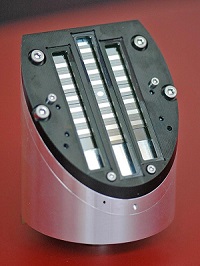Fraunhofer researchers have developed a 3D laser scanner with a light-travel time measurement system that is based on the human eye and that can focus on key sections of an image and capture them with a correspondingly higher resolution. The system functions independently of ambient light and delivers high-quality 3D information in real time, even over greater distances. A novel MEMS scanning technology developed by the Fraunhofer Institute for Photonic Microsystems IPMS in Dresden is the key hardware component. The institute will present the micro reflector components to a wider specialist audience at Vision in Stuttgart from November 4 – 6, 2014.
The development of imaging sensors in the two-dimensional camera area is characterized by ever increasing pixel and frame rates. The resolution of the camera is usually only limited by the optics. The situation is very different in the 3D sensor area. Even though depth information, which is used for many tasks such as navigation, identification or monitoring of expensive or dangerous facilities is gaining importance for even more accurate, faster and most of all more reliable data analysis, there is currently no 3D sensor that would be able to identify security-relevant outside objects over a greater distance with very different light effects with sufficient speed and accuracy.
It is precisely for cases like these that the three institutes of the Fraunhofer-Gesellschaft, namely the Fraunhofer Institute for Physical Measurement Techniques IPM in Freiburg, the Fraunhofer Institute for Intelligent Analysis and Information Systems IAIS in Sankt Augustin and the Fraunhofer Institute for Photonic Microsystems IPMS in Dresden have now found a solution. Working in a team, the scientists have combined pulse run time – laser distance measurement and an adaptive operating micro reflector component (MEMS) into a novel laser scanning system. Adaptive means that the image section can be quickly adjusted to the respective area of interest, in accordance with the fovea that is located in the human eye, which ensures that we can see small sections of an overall image in greater focus. Efficient software algorithms analyze a quickly recorded 3D overview image and direct the scanner (the ?attention? of the system) to interesting image sections, so they can be scanned at a high resolution. This is the first time that situation-based high-quality 3D information can be obtained within such a short time period.
Fraunhofer IPMS was responsible for the scanning system concept, while Fraunhofer IPM provided the TOF laser measurement technology and Fraunhofer IAIS contributed its software development competence for attention control into the system development process. Project manager Dr. Thilo Sandner explains how the system works: ?The reflector mechanism of our laser scanner directs the time-modulated transmission beam over the object that is to be measured. The light of the transmission beam that is dispersed over that area is shown on a photo-detector with a high bandwidth using several receiving reflectors that move synchronous to the beam, and the distance of the object is determined using the measured phase or pulse run time of the light that is received.? The scanning system concept is based on a 1D MEMS Array that performs resonant scanning in a vertical direction, which can be pivoted and rotated with a conventional electro-dynamic drive. We were able to significantly increase the visual fill factor with the use of 22 receiving reflectors with individual apertures of 8.4 × 2.3 mm² and integrated reflector position sensors, and thus created the technical conditions for performing measurements from distances of up to 30 meters. Similar to conventional laser scanners, and in contrast to camera-based technologies, the strength of the laser scanning technology is its ability to disregard the presence of different light conditions, which predestines the technology for outside applications. The extremely high scanning speed of the Fraunhofer scanner of 1.6 kHz makes it possible to scan images almost in real time, and thus it is also suitable for scanning moving objects such as air planes on the runway, or vehicles on construction sites.
The complete scan head of the laser scanning system will be presented to a specialist audience at the trade fair stand of Fraunhofer IPMS, number 1H73, at the Vision specialist trade fair in Stuttgart from November 4 – 6, 2014, in addition to other MEMS developments and systems.
About Fraunhofer IPMS
The Fraunhofer Institute for Photonic Microsystems IPMS is a leading international research and development service provider in the fields of photonic microsystems, microsystems technology and wireless microsystems. The Dresden research institute has many years of experience in the development of components, modules and systems for optical wireless communication and offers solutions for all speed classes in the multi-gigabit range for both infrared and visible light. The Fraunhofer IPMS is a member of the Infrared Data Association (IrDA) and is in charge of the 10 Giga-IR Special Interest Group.






